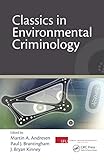Classics in environmental criminology
Publication details: London CRC Press 2010Description: 535p xiISBN:- 9781439817797
- 364.000000 AND
| Item type | Current library | Call number | Status | Date due | Barcode |
|---|---|---|---|---|---|
 BOOKs
BOOKs
|
National Law School | 364 AND (Browse shelf(Opens below)) | Available | 24274 |
Table of Contents:
Section I - Early Work on the Ecology of Crime;
1. The Place of Environmental Criminology within Criminological Thought; M.A. Andresen;
2. Of the Development of the Propensity to Crime (1842); L.A.J. Quetelet;
3. Localities of Crime in Suffolk (1856); J. Glyde;
4. Juvenile Delinquency in a Small City (1916); E.W. Burgess;
5. Juvenile Delinquency and Urban Areas: A Study of Rates of Delinquency in Relation to Differential Characteristics of Local Communities in American Cities (1969); C.R. Shaw and H.D. McKay;
6. Urban Ecological Aspects of Crime in Akron (1974); G.F. Pyle, E.W. Hanten, P.G. Williams, A.L. Pearson II, J.G. Doyle, and K. Kwofie;
7. Intraurban Crime Patterns (1974); K.D. Harries;
Section II - Classics in Environmental Criminology;
8. Social Change and Crime Rate Trends: A Routine Activity Approach (1979); L.E. Cohen and M. Felson;
9. Routine Activities and Crime: An Analysis of Victimization in Canada (1990); L.W. Kennedy and D.R. Forde;
10 Notes on the Geometry of Crime (1981); P.L. Brantingham and P.J. Brantingham;
11. The Use of Space in Burglary (1985); G.F. Rengert and J. Wasilchick;
12. Nodes, Paths, and Edges: Considerations on the Complexity of Crime and the Physical Environment (1993); P.L. Brantingham and P.J. Brantingham;
13. Modeling Offenders’ Decisions: A Framework for Research and Policy (1985); R.V. Clarke and D.B. Cornish;
14. Linking Criminal Choices, Routine Activities, Informal Control, and Criminal Outcomes (1986); M. Felson;
15. Understanding Crime Displacement: An Application of Rational Choice Theory (1987); D.B. Cornish and R.V.G. Clarke;
16. Environment, Routine, and Situation: Toward a Pattern Theory of Crime (1993); P.L. Brantingham and P.J. Brantingham;
Section III - Environmental Criminology and Crime Prevention;
17. A Conceptual Model of Crime Prevention (1976); P.J. Brantingham and F.L. Faust;
18. Crime Prevention and Control through Environmental Engineering (1969); C.R. Jeffery;
19. Criminal Behavior and the Physical Environment: A Perspective; C.R. Jeffery;
20. Situational Crime Prevention: Theory and Practice; R.V.G. Clarke;
21. Routine Activities and Crime Prevention in the Developing Metropolis (1987); M. Felson;
22. Future Spaces: Classics in Environmental Criminology—Where Do We Go from Here? B. Kinney;
References;
Index.

There are no comments on this title.